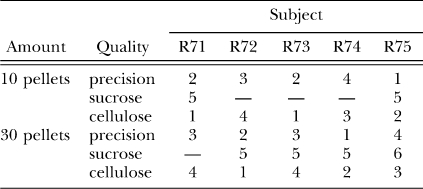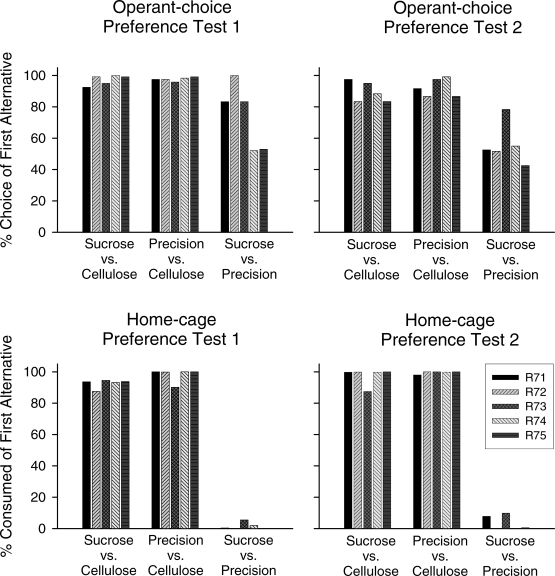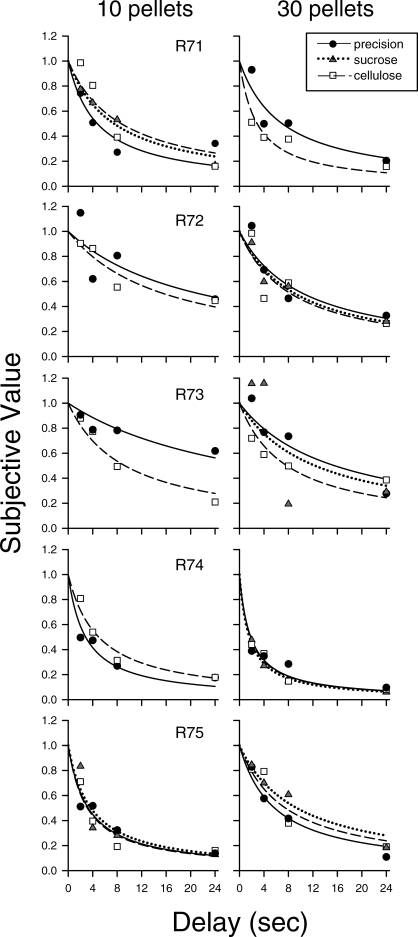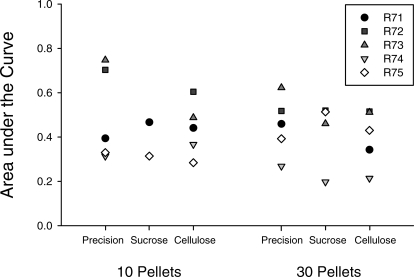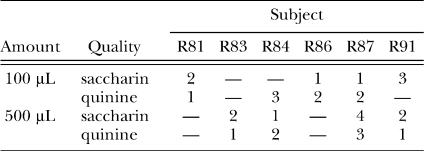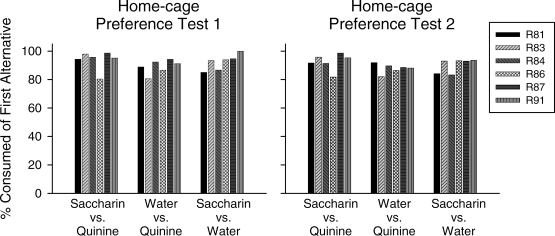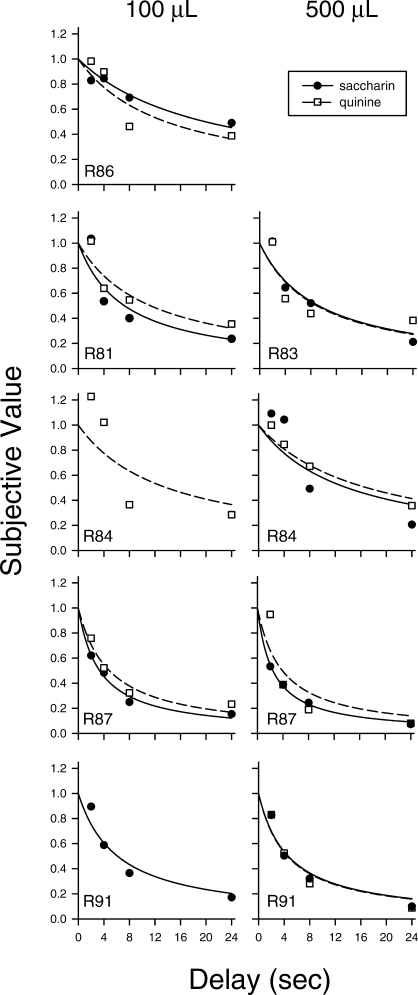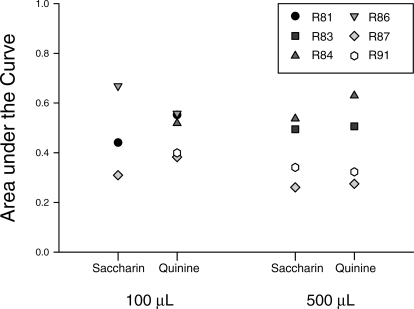Abstract
Humans discount larger delayed rewards less steeply than smaller rewards, whereas no such magnitude effect has been observed in rats (and pigeons). It remains possible that rats' discounting is sensitive to differences in the quality of the delayed reinforcer even though it is not sensitive to amount. To evaluate this possibility, Experiment 1 examined discounting of qualitatively different food reinforcers: highly preferred versus nonpreferred food pellets. Similarly, Experiment 2 examined discounting of highly preferred versus nonpreferred liquid reinforcers. In both experiments, an adjusting-amount procedure was used to determine the amount of immediate reinforcer that was judged to be of equal subjective value to the delayed reinforcer. The amount and quality of the delayed reinforcer were varied across conditions. Discounting was well described by a hyperbolic function, but no systematic effects of the quantity or the quality of the delayed reinforcer were observed.
Keywords: delay discounting; choice; behavioral economics; reinforcer quality; reinforcer amount; magnitude effect; lever press, rat
For pigeons and rats, the relation between the subjective value of a reinforcer and the delay until its receipt is well described by a discounting function of the form:
| 1 |
where V is the subjective value of the delayed reinforcer, A is the amount of the delayed reinforcer, D is the delay to reinforcer delivery, and k is a parameter that reflects the discount rate (Mazur, 1987). Typically, human delay discounting data are better fit if the denominator of Equation 1 is raised to a power (e.g., Myerson & Green, 1995), but this is rarely necessary with data from nonhuman animals.
Another difference between discounting by humans and nonhumans is that in humans, the rate of discounting depends on the amount of the delayed reward, with larger amounts discounted less steeply than smaller amounts. This finding, termed the magnitude effect, has been demonstrated repeatedly in humans with different types of hypothetical rewards: with larger and smaller amounts of money (Green, Myerson, & McFadden, 1997; Kirby, 1997), cigarettes (Baker, Johnson, & Bickel, 2003), heroin (Giordano et al., 2002), and health outcomes (Chapman, 1996). In contrast, studies of nonhuman animals discounting delayed food or liquid reinforcers have failed to observe a magnitude effect (Green, Myerson, Holt, Slevin, & Estle, 2004; Richards, Mitchell, de Wit, & Seiden, 1997). There is even some evidence that this may be the case in nonhuman primates (Freeman, Green, Myerson, & Woolverton, 2009).
The basis for this difference between the results of studies of humans and other animals is unclear, but it is apparently not due to differences in the types of delayed outcomes studied. Although most human studies have involved choices between hypothetical outcomes, Kirby (1997) and Johnson and Bickel (2002) observed magnitude effects with both real and hypothetical monetary rewards. Moreover, Jimura, Myerson, Hilgard, Braver, and Green (2009) recently reported that humans discount larger amounts of real liquid rewards less steeply than smaller amounts.
The fact that the same equation provides a good description of both human and nonhuman delay discounting data suggests that decision-making processes are relatively preserved across species, whereas the apparent absence of a magnitude effect in nonhumans highlights what might be an important difference. For example, delay discounting in humans may involve aspects of language, as indicated by framing effects (Kahneman & Tversky, 1984), that may interact with the way in which rewards are devalued with delay (Grace & McLean, 2005).
Before concluding that nonhuman animals do not show magnitude effects, we wanted to revisit this issue using a different, more general conceptualization of magnitude. More specifically, one can conceptualize magnitude effects as reflecting the shallower discounting of more highly valued reinforcers. Larger and smaller amounts of reward certainly differ in value, but there also are other determinants of value. For example, given a choice between equal amounts of two qualitatively different reinforcers, the one that is highly preferred may be assumed to have greater value (Rachlin, 1971). Accordingly, the present study explored the possibility that in nonhuman animals, one might observe a magnitude effect with qualitatively different reinforcers even though magnitude effects are not observed with different amounts of the same reinforcer. That is, it is possible that animals' discounting may be more sensitive to reinforcer quality than quantity, and thus highly preferred delayed reinforcers may be discounted less steeply than nonpreferred delayed reinforcers.
Although evidence suggests that reinforcer amount and quality function similarly under other circumstances (e.g., Ettinger, McSweeney, & Norman, 1981; Hutt, 1954; Miller, 1976), the question of whether humans differ from other animals with respect to discounting seems of sufficient importance to bear the closest examination. This is especially true given that a recent discounting study (Jimura et al., 2009) showed that humans, like nonhumans (e.g., Richards et al., 1997), discount real liquid rewards delayed by only seconds, thereby calling into question what had appeared to be a robust species difference—the supposedly greater impulsivity or impatience of nonhumans relative to humans.
If the value of a reinforcer is a function of both its quality and quantity (Rachlin, 1971), and magnitude effects reflect the shallower discounting of more highly valued reinforcers, then increasing the quality of a delayed reinforcer might be expected to decrease the rate at which it is discounted. Farrar, Kieres, Hausknecht, de Wit, and Richards (2003) attempted to test this hypothesis by comparing rats' discounting of delayed sucrose reinforcers that differed in concentration and found that the sweetest (30%) solution was discounted more steeply than weaker (3% and 10%) solutions. These results were the exact opposite of what was expected based on the assumption that the sweetest solution would be the most valued and therefore discounted less steeply than weaker, lower valued solutions.
Given these apparently anomalous results, Farrar et al. (2003) conducted a follow-up experiment using the same discounting procedure, but varying the concentration of the delayed solution while holding the concentration of the immediate solution constant at 3%. Only one 4-s delay condition was studied. Farrar et al. found that when the concentration of the delayed solution was 30%, the amount of immediate 3% solution chosen equally often was significantly lower than when the concentration of the delayed solution was 3% or 10%. Farrar et al. interpreted these results as indicating that the 30% solution was the least preferred, in which case the lowest valued reinforcer in Experiment 2 was discounted the most steeply in Experiment 1, a result that would be consistent with a magnitude effect in rats. However, they also indicated that further studies which determine entire discounting functions are needed, and, we might add, such studies should also conduct standard preference tests using the same animals in which discounting is measured.
Accordingly, the first experiment of the present study was designed as a systematic replication of Farrar et al. (2003) in which, unlike the previous study, rats' preferences among several foods were tested before they began the discounting experiment, as well as during and at the end of the experiment. The amount of the delayed food reinforcer also was varied across discounting conditions. A second experiment examined the effect of varying the quality and amount of liquid reinforcers on rats' delay discounting.
EXPERIMENT 1
Method
Subjects
Five naïve, male, Sprague-Dawley rats, obtained from Charles River Laboratories International, were individually housed in an animal colony room with a 12:12 hr light/dark cycle. Rats were approximately 120 days old at the beginning of the study. The rats had water continuously available in their home cages and were provided 1-hr access to food (Purina Rodent Diet, LabDiet 5001) after each daily session.
Apparatus
Two experimental chambers (Coulbourn Instruments, Inc.), 28 cm long, 23 cm wide, and 30.5 cm high, were housed within sound- and light-attenuating enclosures equipped with ventilation fans that masked extraneous noise. Stimuli were presented and responses were recorded using a MED Associates interface and MED-PCTM software running on a personal computer in an adjacent room.
Three retractable steel response levers, 4.8-cm wide and extending 1.9 cm into the chamber, were mounted on the front panel of the experimental chamber. When extended, a 0.25 N force was required to operate a lever. Right and left response levers were located 19 cm above the grid floor and 15.2 cm apart. The center lever was located 15.2 cm above the floor and was centered on the front panel. A 7-W white houselight was mounted in the center of the ceiling. Three triple-cue lamps were used, each capable of displaying red-, yellow-, and green-colored LED stimuli. Each LED was 1 cm wide and 1 cm high; the three LEDs were arranged horizontally with 1 cm between them. One triple-cue lamp was mounted 5 cm above each response lever, and only one color was active for each lamp: green over the right lever, yellow over the center lever, and red over the left lever. Food pellets (14 mg) could be dispensed into either of two food magazines located below the right and left levers and 1.3 cm above the grid floor. During reinforcement, a white light illuminated the food magazine in use, and pellets were dispensed at a rate of one every 0.6 s. The light remained illuminated until 3 s had elapsed after the rat removed its head from the magazine. Infrared photo detectors were mounted in the food magazine to detect when the rat's head entered the magazine.
Home cage preference tests were conducted in a 46- x 24- x 20-cm cage similar to the rats' home cages. Two 14 x 5.7 x 3.2-cm feeding troughs were mounted on the floor in the right and left corners along the length of the cage.
Three types of food pellets were used: Sucrose pellets (100% sucrose pellets, Research Diets, Formula PJFSC); cellulose pellets (75% cellulose/ 25% sucrose pellets, Research Diets, Formula PJF-75% Cellulose); and precision pellets (Research Diets, Formula PJPPP). The precision pellet consisted of approximately 50% sucrose by weight and provided complete nutrition.
Procedure
Training
On each of 3 days, rats were given 1-hr free access to one of the pellet types in their home cages to familiarize them with the pellets. They then were trained to eat from the lighted magazines for two sessions. After pressing was shaped on the center lever, the rats were exposed to a fixed-ratio 1 (FR 1) schedule in which the right and left levers alternated randomly for three sessions. Each of these three sessions ended when 200 pellets had been delivered. The type of pellet varied across sessions, and each rat was exposed to the pellets in a different order.
Preference Tests
Four preference tests were conducted during the experiment. The first and second preference tests, which were conducted prior to the discounting procedure and following the first four discounting conditions, respectively, used an operant-choice procedure. The third and fourth preference tests were conducted in a cage similar to the subjects' home cages. The third test was conducted on the days immediately following the second preference test, and the fourth and final test was conducted immediately following the final discounting condition.
Operant-choice preference tests
In separate sessions, rats were given a choice between each of the three possible pairings of pellet types with each pairing being presented twice in order to control for side preferences. Thus, there were six possible pairings: sucrose versus cellulose and cellulose versus sucrose, sucrose versus precision and precision versus sucrose, cellulose versus precision and precision versus cellulose. The six pairings were arranged into two randomly ordered sequences. Rats 71, 72, and 73 were tested with one sequence, and Rats 74 and 75 with the other. At least three sessions were conducted for each pairing, and each testing with each pairing was terminated when percentage choice during free-choice trials for a side did not vary by more than 10% for two consecutive sessions.
Operant-choice preference tests were conducted daily, and each testing session ended after four blocks of trials had been completed or 45 min had elapsed, whichever came first. Each block of trials consisted of 4 forced-choice trials followed by 10 free-choice trials. Of every four forced-choice trials, two were forced choices to the right lever and two to the left lever, presented in a random order across blocks.
The beginning of a trial was signaled by illumination of the center yellow cue light and the extension of the center lever into the chamber. On free-choice trials, a single press retracted the center lever, darkened the center cue light, extended the right and left levers into the chamber and illuminated the right (green) and left (red) cue lights. A press on the right lever retracted both levers, darkened the left cue light and the houselight, and initiated a 0.5-s delay, during which only the right cue light remained illuminated. After the delay, the cue light was extinguished, the right magazine light illuminated, and five pellets were dispensed into the right magazine at a rate of one pellet every 0.6 s. Similarly, a press on the left lever retracted both levers, darkened the right cue light and the houselight, and initiated a 0.5-s delay, during which only the left cue light remained illuminated. After the delay, the cue light was extinguished, and five pellets were dispensed into the left magazine. On both left and right choice trials, the magazine light was extinguished 3 s after the rat removed its head from the magazine, and the houselight reilluminated. Seventy seconds after a choice response, the next trial began. The procedure on forced-choice trials was similar except that only one side lever was extended and active, and only its cue light illuminated.
Home-cage preference tests
Test sessions were administered at approximately the same time daily and consisted of 30 min of free access to two types of food pellets. Tests began by placing the rat in the cage approximately equidistant from the right and left food troughs, each of which contained 80 g of food pellets. After 30 min had elapsed, rats were returned to their home cages and given 1 hr of access to food (Purina Rodent Diet) and free access to water. Preference was measured as the percentage of pellets consumed of each type out of the total eaten during that session. Rats were initially exposed to one pairing, and on the following session, the position of each pellet type in the cage was reversed. Each pairing and location was presented for one session, for a total of six sessions. Only one preference test session was conducted each day. On the days in which a preference test session was conducted, no other experimental procedures were implemented.
Delay Discounting Procedure
Experimental sessions were conducted daily. Sessions ended after 8 (for the larger amount condition) or 10 (for the smaller amount condition) blocks of trials had been presented or after 75 min had elapsed, whichever came first. Each block of trials began with two forced-choice trials followed by two free-choice trials. One of the forced-choice trials was to the delayed, standard alternative, and the other was to the adjusting, immediate alternative. Which forced-choice trial came first was randomly determined.
As in the operant-choice preference tests, the beginning of a trial was signaled by illumination of the center yellow cue light and the extension of the center lever into the chamber. On free-choice trials, a single press retracted the center lever, darkened the center cue light, extended the right and left levers into the chamber and illuminated the right (green) and left (red) cue lights. A press on the right lever retracted both levers, darkened the left cue light and the houselight, and initiated a delay whose duration varied across conditions. After the delay, the cue light was extinguished, the right magazine light illuminated, and either 10 or 30 pellets were dispensed into the right magazine, depending on the amount condition. Similarly, a press on the left lever retracted both levers, darkened the right cue light and the houselight, and initiated a 0.5-s delay, after which, the cue light was extinguished and a variable number of pellets (determined by choices in the previous block of trials) was dispensed into the left magazine. Three seconds after the rat removed its head from the magazine, the magazine light was extinguished and the houselight was reilluminated. Seventy seconds after a response on either the left or right lever, a new trial began. The procedure on forced-choice trials was similar except that only one side lever was extended and only its cue light illuminated.
For the first block of trials in a phase, a response on the left, adjusting-amount lever produced a single pellet and a response on the right, standard-amount lever was either 10 or 30 pellets, depending on the condition. On subsequent blocks, the number of pellets for a choice of the adjusting alternative depended on choices in the preceding block. If the rat had chosen the adjusting, immediate alternative on both free-choice trials, then the number of pellets for this alternative decreased by one, whereas if the rat had chosen the standard alternative on both free-choice trials, then the number of pellets increased by one. If the rat had chosen both the adjusting and the standard alternative during the preceding block, then the number of pellets for the adjusting alternative was not changed. After the first session in each phase, the starting value (i.e., the number of pellets) for the adjusting alternative in subsequent sessions was determined based on the choices in the final block in the preceding session.
Discounting conditions differed in the amount of the standard, delayed alternative and also in the types of food pellet delivered for responses on the standard- and adjusting-amount levers. Specifically, two amounts (10 and 30 pellets) were crossed with three pellet types (precision, cellulose, and sucrose) for a total of six possible conditions. Four rats completed five conditions; the remaining rat completed all six conditions. At minimum, then, all rats completed a quality comparison at two amounts and an amount comparison at two qualities.
Within a condition, indifference points were determined at each of four delays to the standard alternative: 2, 4, 8, and 24 s. For example, in the 4-s delay phase of the 10-pellet/precision-pellet condition, the rat would choose between an adjusting number of precision pellets that were received immediately and 10 precision pellets that were received after a 4-s delay. Once the animal was indifferent between these two alternatives, a different standard delay phase was initiated. The order of these delays was varied between conditions and between rats. All standard delay phases were completed before a new condition was begun. Each rat experienced the 10- and 30-pellet precision and cellulose conditions in a different order. In addition, 4 rats subsequently experienced either the 10- or 30-pellet sucrose condition, and 1 rat experienced both. The order of conditions for each rat is given in Table 1. The number of sessions to indifference for a condition, summed across the four delay phases, ranged from 68 to 155.
Table 1.
Order of delay discounting conditions for each rat for Experiment 1.
| Subject | ||||||
| Amount | Quality | R71 | R72 | R73 | R74 | R75 |
| 10 pellets | precision | 2 | 3 | 2 | 4 | 1 |
| sucrose | 5 | — | — | — | 5 | |
| cellulose | 1 | 4 | 1 | 3 | 2 | |
| 30 pellets | precision | 3 | 2 | 3 | 1 | 4 |
| sucrose | — | 5 | 5 | 5 | 6 | |
| cellulose | 4 | 1 | 4 | 2 | 3 | |
Indifference between the choice alternatives was assessed after a minimum of 150 blocks of trials. Indifference was determined as follows. The last 50 blocks of trials were divided into 10 groups of five blocks each, and the mean number of pellets delivered by the adjusting alternative for each of these 10 block-groups was determined. These 10-block means then were compared to the overall adjusting-alternative mean for the same 50 blocks. A rat was considered to be indifferent between the alternatives when (a) none of the means of the 10 block-groups deviated by more than two pellets from the overall mean, (b) neither the first nor the last of these 10 block-group means contained the highest or the lowest mean value, and (c) there was no visible upward or downward trend in the block-group means. When these criteria were met, the indifference point was the mean number of pellets over the last 50 blocks.
Results
Preference Tests
As may be seen in Figure 1, each rat strongly preferred the sucrose and the precision pellets to the cellulose pellets in both the operant-choice and home-cage preference tests. For example, on the first operant-choice preference test, sucrose pellets were chosen over cellulose pellets on 92.5 to 100% (M = 97.2%) of the trials, and precision pellets were chosen over cellulose pellets on 95.8 to 99.2% (M = 97.7%) of the trials. Preference between sucrose and precision pellets, however, was more variable: Rats 71, 72, and 73 preferred the sucrose pellets on the first operant-choice test (percentage choice ranged from 88.3 to 100%), whereas Rats 74 and 75 were indifferent between the two types of pellets (52.1 and 52.9% choice).
Fig 1.
Results of the preference tests for each rat in Experiment 1. Bars show the percentage choice (upper panels) and percentage consumed (lower panels) of the alternative that appears first in the pairs noted along the x-axis. The upper panels show results from the operant-choice preference tests; the lower panels show results from the home-cage preference tests.
Choice between the preferred and nonpreferred types of pellets (i.e., sucrose and precision vs. cellulose) remained unchanged across preference tests. This is important because it makes possible a clear contrast between discounting of preferred and nonpreferred pellets. Choice between the two types of preferred pellets, however, did vary by test type and occasion. Two rats changed their preference between the first and second operant-choice tests: Rats 71 and 72 went from preferring sucrose to precision pellets to relative indifference between the two. In contrast, all rats strongly preferred the precision pellets to the sucrose pellets in both home-cage tests whereas none did in the operant-choice tests.
Delay Discounting
Figure 2 shows relative subjective value (i.e., subjective value of the delayed reinforcer as a proportion of its actual amount) as a function of delay for each reinforcer amount (10 and 30 pellets) and type (precision, sucrose, and cellulose pellets). Equation 1 was fitted to the data for each condition, and the curves represent the least squares best fits. Estimates of the discount rate parameter, k, and the proportion of variance accounted for (R 2) are given in Table 2. A simple hyperbola (Eq. 1) accounted for 49 to 98% of the variance in subjective value for individual rats (median = 83.5%).
Fig 2.
Delay discounting functions for the 10-pellet (left panels) and 30-pellet (right panels) conditions for each rat in Experiment 1. Symbols show subjective values of the three types of food reinforcers expressed as a proportion of the delayed amount. Curves represent the best-fitting discounting functions (Equation 1).
Table 2.
Parameter estimate (k) and proportion of variance accounted for (R 2) by Equation 1 for fits to individual and group mean data for different reinforcer amounts and pellet types in Experiment 1.
| 10 pellets | 30 pellets | |||||||||||
| Precision | Sucrose | Cellulose | Precision | Sucrose | Cellulose | |||||||
| Subject | k | R2 | k | R2 | k | R2 | k | R2 | k | R2 | k | R2 |
| R71 | 0.21 | .67 | 0.13 | .96 | 0.12 | .83 | 0.14 | .84 | — | — | 0.35 | .66 |
| R72 | 0.05 | .58 | — | — | 0.06 | .88 | 0.09 | .82 | 0.11 | .91 | 0.12 | .70 |
| R73 | 0.03 | .67 | — | — | 0.11 | .94 | 0.06 | .86 | 0.08 | .50 | 0.13 | .49 |
| R74 | 0.35 | .77 | — | — | 0.20 | .94 | 0.54 | .61 | 0.61 | .98 | 0.56 | .93 |
| R75 | 0.31 | .82 | 0.27 | .80 | 0.32 | .86 | 0.17 | .95 | 0.11 | .94 | 0.13 | .88 |
| Group | 0.13 | .81 | 0.19 | .95 | 0.14 | .94 | 0.14 | .96 | 0.15 | .94 | 0.20 | .97 |
Inspection of the k parameters for the different conditions reveals no systematic difference in rate of discounting as a function of either reinforcer amount or type. Only 1 of the 5 rats (R75) consistently discounted the smaller amount of each pellet type more steeply than the larger amount, and only 1 rat (R73) consistently discounted the non-preferred cellulose pellets more steeply than highly preferred pellets at both amounts. Note, however, that the rat that showed an effect of amount on rate of discounting did not show an effect of type of reinforcer, and the rat that showed an effect of reinforcer type did not show an effect of amount. Moreover, 2 rats (R72 and R74) showed some evidence of consistent amount-dependent discounting, but in the direction opposite to that of the magnitude effect, discounting the smaller amount less steeply than the larger amount regardless of pellet quality.
The area-under-the-curve (AuC) measure provides another basis for evaluating the degree of discounting, one that does not require assuming a particular theoretical form for the discounting function (Myerson, Green, & Warusawitharana, 2001). Inspection of Figure 3, which shows the AuC for each rat for each of the discounting conditions, reveals no evidence of any systematic difference in discounting rate across either reinforcer amounts or types (note that a smaller AuC indicates steeper discounting). Again, R75 showed consistently steeper discounting of the smaller delayed amount. R73, the one rat to show a consistent effect of quality in the preceding comparison based on estimates of the k parameter, showed a quality effect for only one of the preferred pellet types (precision pellets) but not the other (sucrose) when AuC values were compared. Overall, both the estimates of the k-parameter and the AuC measures suggest that rats show equivalent discounting of smaller and larger amounts of preferred and nonpreferred food reinforcers.
Fig 3.
Area under the discounting curve for each type of food reinforcer for each rat in Experiment 1. Steeper discounting is indicated by lower values.
Discussion
Results from all four of the preference tests indicated that every rat strongly preferred the precision and sucrose pellets to the cellulose pellets. Rats' preference between the precision and sucrose pellets was less clear in that different results were obtained with the different types of preference tests. Preference for precision pellets, as measured by the operant-choice test, increased from the first to second testing occasions in 2 rats, perhaps because of the effect of familiarity (Hill, 1978; Partridge, 1981) due to the fact that they had extensive experience in two discounting conditions with precision pellets but none with the sucrose pellets over this time period. Thus, although it is unclear whether the rats actually had a preference between these two pellet types, what is clear is that both were overwhelmingly preferred to the cellulose pellets.
If more preferred reinforcers are valued more highly, then (by analogy with magnitude effects in human studies) such reinforcers might be expected to be discounted less steeply than less preferred reinforcers. However, the results of Experiment 1 are not consistent with this expectation in that the two highly preferred reinforcers (precision and sucrose pellets) were not discounted less steeply than the least preferred reinforcer (cellulose pellets). In addition, 30-pellet reinforcers were not discounted less steeply than 10-pellet reinforcers. Thus, the present results are consistent with those of previous studies of nonhuman animals in which smaller and larger amounts of reinforcers were discounted at equivalent rates (Green et al., 2004; Richards et al., 1997), in contrast to the many reports of a magnitude effect in humans (e.g., Green et al., 1997; Kirby, 1997).
EXPERIMENT 2
The one previous report of a magnitude effect in rats based on comparison of different sucrose concentrations (Farrar et al., 2003) did not measure preference among the sucrose concentrations in the same subjects in whom discounting was measured. In addition, the Farrar et al. study used liquid reinforcers whereas the present study used food pellets. Accordingly, we conducted a second experiment in which we compared rats' discounting of two liquid reinforcers, after assessing their preferences among three different reinforcers in order to establish which was the most and which was the least preferred.
Method
Subjects
Six naïve male Sprague-Dawley rats, obtained from Charles River Laboratories International and approximately 120 days old at the beginning of the experiment, were individually housed in an animal colony room with a 12:12 hr light/dark cycle. The rats had food continuously available in their home cages (Purina Rodent Diet, LabDiet 5001) and were provided 30 min of access to water after each daily session.
Apparatus
For the discounting procedure, two experimental chambers (Coulbourn Instruments, Inc.) were used. All dimensions of the chamber and equipment were the same as those from Experiment 1 except that recessed steel cups, 3 cm in diameter, were used as receptacles for the liquid reinforcers. Liquids were dispensed into the cups by syringe pumps (Med Associates, Inc, PHM-100) containing 60-cc plastic syringes connected to the cups via sterile plastic tubing. Each chamber was equipped with two pumps, one connected to the right cup and the other connected to the left cup. The rate at which the liquids were dispensed was 177 µL/s. The flow rate was checked once per week throughout the experiment and never varied by more than 4 µL/s.
Home-cage preference tests were performed in a cage similar to the rats' home cage. Two 60-cc syringes with a lick-tube rubber stopper and filled with 50 cc of liquid were placed on the right and left sides of the cage's ceiling grate. Three types of liquids were used in the experiment: saccharin (0.25% wt/vol saccharin sodium salt hydrate in distilled water); quinine (0.008% wt/vol quinine hydrochloride dyhydrate in distilled water); and water (distilled water). For each rat, only the most and least preferred liquids were used in the discounting conditions.
Procedure
Training
On each of 3 days, the rats were given 1-hr free access to one of the liquids in their home cages to familiarize them with each of the liquids. After this familiarization, the rats were placed in the operant chamber and trained to drink from the lighted cups for two sessions. All other aspects of training were similar to Experiment 1.
Preference tests
Home-cage preference tests similar to those in Experiment 1 were conducted on two occasions, once prior to the discounting conditions and again at the conclusion of the discounting conditions.
Delay discounting procedure
All aspects of the discounting procedure were similar to Experiment 1, except for those pertaining to delivery of the reinforcer. Conditions differed in the amount of the standard, delayed alternative and the type of liquid reinforcer used. Specifically, two delayed amounts (100 µL and 500 µL) were crossed with two types of liquid (saccharin and quinine) for a total of four possible conditions. Two rats completed two discounting conditions, 3 rats completed three conditions, and the remaining rat completed all four conditions.
At a minimum, each rat completed at least one comparison of the same amount of two different types of liquid reinforcer. The first two conditions for 3 of the rats involved the two types of 100-µL delayed reinforcers; for the other 3 rats the first two conditions involved the two types of 500-µL delayed reinforcers. The order of conditions for each rat is given in Table 3. The number of sessions to indifference for a condition, summed across the four delay phases, ranged from 104 to 299.
Table 3.
Order of delay discounting conditions for each rat for Experiment 2.
| Subject | |||||||
| Amount | Quality | R81 | R83 | R84 | R86 | R87 | R91 |
| 100 µL | saccharin | 2 | — | — | 1 | 1 | 3 |
| quinine | 1 | — | 3 | 2 | 2 | — | |
| 500 µL | saccharin | — | 2 | 1 | — | 4 | 2 |
| quinine | — | 1 | 2 | — | 3 | 1 | |
Indifference between choice alternatives was assessed in a similar manner to that used in Experiment 1. Of the three criteria used previously, the only difference was that a rat was considered to be indifferent between the alternatives when none of the means of the 10 block-groups deviated by more than 20% of the overall mean.
Results
Preference Tests
Figure 4 shows the results of the home-cage preference tests which revealed that each rat overwhelmingly preferred the saccharin to the quinine solution, the water to the quinine solution, and the saccharin solution to the water. When saccharin was compared to quinine, saccharin consumption ranged from 80.4 to 98.7% (M = 93.7%) of the total liquid consumed in the first preference test and from 81.7 to 98.6% (M = 92.4%) in the second test. When water was compared to quinine, water consumption ranged from 80.6 to 94.3% (M = 90.0%) of the total liquid consumed in the first preference test and from 82.0 to 91.9% (M = 87.7%) in the second test. Finally, when saccharin was compared to water, saccharin consumption ranged from 85.1 to 100.0% (M = 92.3%) in the first test and from 83.2 to 93.5% (M = 90.0%) in the second test. These results indicate that saccharin was the most highly preferred liquid whereas quinine was the least preferred. Thus, comparison of the discounting of saccharin and quinine provides a stringent test of whether rats discount preferred reinforcers less steeply than nonpreferred reinforcers.
Fig 4.
Results of the preference tests for each rat in Experiment 2. Bars show the percentage consumed of the alternative that appears first in the pairs noted along the x-axis.
Delay Discounting
Figure 5 shows relative subjective value as a function of delay for 100- and 500-µL saccharin and quinine reinforcers. Equation 1 was fitted to the data for each condition, and the curves represent the least squares best fits. Estimates of the discount rate parameter, k, and the proportion of variance accounted for (R 2) are given in Table 4. A simple hyperbola (Eq. 1) accounted for 60 to 99% of the variance in subjective value for individual rats (median = 88.5%). Inspection of the k parameter values at each delayed amount reveals that the preferred saccharin reinforcer was discounted less steeply than the quinine reinforcer in only one out of seven cases. Moreover, the larger amount of reinforcer was discounted less steeply than the smaller amount in only one case but more steeply in three cases.
Fig 5.
Delay discounting functions for the 100-µL (left panels) and 500-µL (right panels) amount conditions for each rat in Experiment 2. Symbols show subjective values of the saccharin and quinine liquid reinforcers expressed as a proportion of the delayed amount. Curves represent the best-fitting discounting functions (Equation 1).
Table 4.
Parameter estimate (k) and proportion of variance accounted for (R 2) by Equation 1 for fits to individual and group mean data for different reinforcer amounts and pellet types in Experiment 2.
| 100 µL | 500 µL | |||||||
| Saccharin | Quinine | Saccharin | Quinine | |||||
| Subject | k | R2 | k | R2 | k | R2 | k | R2 |
| R81 | 0.14 | .77 | 0.09 | .83 | — | — | — | — |
| R83 | — | — | — | — | 0.11 | .87 | 0.11 | .69 |
| R84 | — | — | 0.07 | .60 | 0.07 | .71 | 0.06 | .93 |
| R86 | 0.05 | .90 | 0.07 | .79 | — | — | — | — |
| R87 | 0.30 | .97 | 0.21 | .94 | 0.41 | .99 | 0.26 | .74 |
| R91 | 0.16 | .91 | — | — | 0.22 | .92 | 0.22 | .90 |
| Group | 0.14 | .96 | 0.10 | .84 | 0.15 | .94 | 0.14 | .87 |
Figure 6, which shows the AuC for each rat for each of the discounting conditions, reveals similar patterns of results with respect to the discounting of the preferred versus the nonpreferred reinforcer at the same amount and the larger versus the smaller amount of the same type of reinforcer. Overall, both the estimates of the k-parameter and the AuC measures suggest that rats show no systematic differences in the rates at which they discount smaller and larger amounts of preferred and non-preferred liquid reinforcers.
Fig 6.
Area under the discounting curve for the saccharin and for the quinine liquid reinforcers for each rat in Experiment 2. Steeper discounting is indicated by lower values.
Discussion
In preference tests both before and after the discounting conditions, every rat overwhelmingly preferred the saccharin to the quinine solution. This extreme difference in preference allows for a clear test of the hypothesis that, analogous to the magnitude effect observed in humans, rats discount more preferred reinforcers less steeply than nonpreferred reinforcers. Despite the extreme preference for saccharin, however, neither the discount rate parameter (k) nor the area-under-the-curve measure of discounting revealed evidence of systematic differences in the rate at which the rats discounted the two types of reinforcer.
GENERAL DISCUSSION
The results of both Experiments 1 and 2 suggest a fundamental difference between nonhuman and human discounting. The rats in these experiments showed no systematic differences between the rates at which they discounted highly preferred and nonpreferred delayed food reinforcers (Experiment 1) or between the rates at which they discounted highly preferred and nonpreferred delayed liquid reinforcers (Experiment 2). Moreover, there were no systematic differences between the discounting of smaller and larger amounts of food (Experiment 1) and liquid (Experiment 2) reinforcers, consistent with previous studies of delay discounting in rats (Green et al., 2004; Richards et al., 1997). Previous studies with pigeons (Green et al., 2004) and monkeys (Freeman et al., 2009) also failed to find an effect of reinforcer amount. These findings stand in contrast to the results of studies with humans, who show robust magnitude effects, discounting larger amounts of delayed rewards less steeply than smaller amounts (for a review, see Green & Myerson, 2004).
Although most reports of magnitude effects in humans concern the discounting of hypothetical monetary rewards, significant magnitude effects also have been observed with other hypothetical rewards, including cigarettes (Baker et al., 2003), heroin (Giordano et al., 2002), and health outcomes (Chapman, 1996), as well as with hypothetical candy, soda, and beer rewards (Estle, Green, Myerson, & Holt, 2007). Humans also have been shown to discount larger amounts of real money less steeply than smaller amounts (Johnson & Bickel, 2002; Kirby, 1997). Importantly, Jimura et al. (2009) recently demonstrated that although liquid-deprived humans, like rats, discount liquid rewards delayed by less than a minute, they nevertheless appear to discount larger delayed amounts of liquid reward less steeply than smaller amounts.
Taken together, this evidence suggests that the absence of a magnitude effect with nonhumans, despite the robustness of such an effect in humans, is not due to differences in the choice outcomes studied. That is, previous studies of discounting in humans have shown that magnitude effects are not restricted to one type of delayed reward (e.g., hypothetical vs. real; monetary vs. directly consumable), and magnitude effects have been observed in humans when subjects were deprived of a real delayed reward and actually had to wait for its delivery. Thus, previous studies with humans have whittled away at the procedural differences that might explain the presence of magnitude effects in humans despite their absence in nonhumans.
The present study took a different approach to the issue of magnitude effects. Previous studies have varied the types of delayed rewards used with humans in order to make them more like those used with nonhumans (i.e., real and directly consumable). Indeed, even when more comparable rewards were used, humans, unlike nonhumans, still showed a magnitude effect (Jimura et al., 2009). In the present study, we varied the types of reinforcers used in order to see if a magnitude effect emerged. Specifically, we compared rats' discounting of qualitatively different reinforcers, reasoning that highly preferred reinforcers are more highly valued. Despite the rats' overwhelming preference for precision food pellets over cellulose pellets (Experiment 1) and for a saccharin solution over a quinine solution (Experiment 2), no systematic differences in the rates at which the different reinforcer types were discounted were observed in either experiment.
There remain, of course, a few potentially important differences between the ways in which discounting studies with human and nonhuman subjects are conducted, and one of these may yet turn out to be responsible for the difference in the response of humans and nonhumans to the value or magnitude of delayed rewards. One difference that may prove to be important is the fact that reward amounts and delays have been symbolically signaled in human studies but not in studies with nonhuman animals (Jimura et al., 2009). If future studies were to show magnitude effects in humans even when amounts and delays are not symbolically signaled, then it will be of interest to determine at what point in human development magnitude effects emerge. Although magnitude effects are already present by age 12 (Green, Fry, & Myerson, 1994), knowing the age at which children first begin to differentially discount larger and smaller delayed outcomes may shed light on the behavioral mechanism involved. Alternatively, further research may yet reveal conditions under which nonhuman animals do show a magnitude effect. Nevertheless, it seems clear that under conditions where one would have expected to observe such effects, they apparently do not occur.
Acknowledgments
The research was supported by NIMH Grant MH055308. ALC was awarded the Experimental Analysis of Behavior Fellowship from the Society for the Advancement of Behavior Analysis. We thank members of the Psychonomy Cabal for their assistance in the running of the experiments.
REFERENCES
- Baker F, Johnson M.W, Bickel W.K. Delay discounting in current and never-before cigarette smokers: Similarities and differences across commodity, sign, and magnitude. Journal of Abnormal Psychology. 2003;112:382–392. doi: 10.1037/0021-843x.112.3.382. [DOI] [PubMed] [Google Scholar]
- Chapman G.B. Temporal discounting and utility for health and money. Journal of Experimental Psychology: Learning, Memory, and Cognition. 1996;22:771–791. doi: 10.1037//0278-7393.22.3.771. [DOI] [PubMed] [Google Scholar]
- Estle S.J, Green L, Myerson J, Holt D.D. Discounting of monetary and directly consumable rewards. Psychological Science. 2007;18:58–63. doi: 10.1111/j.1467-9280.2007.01849.x. [DOI] [PubMed] [Google Scholar]
- Ettinger R.H, McSweeney F.K, Norman W.D. Contrast and undermatching as a function of reinforcer duration and quality during multiple schedules. Journal of the Experimental Analysis of Behavior. 1981;35:271–282. doi: 10.1901/jeab.1981.35-271. [DOI] [PMC free article] [PubMed] [Google Scholar]
- Farrar A.M, Kieres A.K, Hausknecht K.A, de Wit H, Richards J.B. Effects of reinforcer magnitude on an animal model of impulsive behavior. Behavioural Processes. 2003;64:261–271. doi: 10.1016/s0376-6357(03)00139-6. [DOI] [PubMed] [Google Scholar]
- Freeman K, Green L, Myerson J, Woolverton W. Delay discounting of saccharin in rhesus monkeys. Behavioural Processes. 2009;82:214–218. doi: 10.1016/j.beproc.2009.06.002. [DOI] [PMC free article] [PubMed] [Google Scholar]
- Giordano L.A, Bickel W.K, Loewenstein G, Jacobs E.A, Marsch L, Badger G.J. Mild opioid deprivation increases the degree that opioid-dependent outpatients discount delayed heroin and money. Psychopharmacology. 2002;163:174–182. doi: 10.1007/s00213-002-1159-2. [DOI] [PubMed] [Google Scholar]
- Grace R.C, McLean A.P. Integrated versus segregated accounting and the magnitude effect in temporal discounting. Psychonomic Bulletin & Review. 2005;12:732–739. doi: 10.3758/bf03196765. [DOI] [PubMed] [Google Scholar]
- Green L, Fry A.F, Myerson J. Discounting of delayed rewards: A life-span comparison. Psychological Science. 1994;5:33–36. [Google Scholar]
- Green L, Myerson J. A discounting framework for choice with delayed and probabilistic rewards. Psychological Bulletin. 2004;130:769–792. doi: 10.1037/0033-2909.130.5.769. [DOI] [PMC free article] [PubMed] [Google Scholar]
- Green L, Myerson J, Holt D.D, Slevin J.R, Estle S.J. Discounting of delayed food rewards in pigeons and rats: Is there a magnitude effect. Journal of the Experimental Analysis of Behavior. 2004;81:39–50. doi: 10.1901/jeab.2004.81-39. [DOI] [PMC free article] [PubMed] [Google Scholar]
- Green L, Myerson J, McFadden E. Rate of temporal discounting decreases with amount of reward. Memory & Cognition. 1997;25:715–723. doi: 10.3758/bf03211314. [DOI] [PubMed] [Google Scholar]
- Hill W.F. Effects of mere exposure on preferences in nonhuman mammals. Psychological Bulletin. 1978;85:1177–1198. [PubMed] [Google Scholar]
- Hutt P.J. Rate of bar pressing as a function of quality and quantity of food reward. Journal of Comparative and Physiological Psychology. 1954;47:235–239. doi: 10.1037/h0059855. [DOI] [PubMed] [Google Scholar]
- Jimura K, Myerson J, Hilgard J, Braver T.S, Green L. Are people really more patient than other animals? Evidence from human discounting of real liquid rewards. Psychonomic Bulletin & Review. 2009;16:1071–1075. doi: 10.3758/PBR.16.6.1071. [DOI] [PMC free article] [PubMed] [Google Scholar]
- Johnson M.W, Bickel W.K. Within-subject comparison of real and hypothetical money rewards in delay discounting. Journal of the Experimental Analysis of Behavior. 2002;77:129–146. doi: 10.1901/jeab.2002.77-129. [DOI] [PMC free article] [PubMed] [Google Scholar]
- Kahneman D, Tversky A. Choices, values, and frames. American Psychologist. 1984;39:341–350. [Google Scholar]
- Kirby K.N. Bidding on the future: Evidence against normative discounting of delayed rewards. Journal of Experimental Psychology: General. 1997;126:54–70. [Google Scholar]
- Mazur J.E. An adjusting procedure for studying delayed reinforcement. In: Commons M.L, Mazur J.E, Nevin J.A, Rachlin H, editors. Quantitative analyses of behavior: Vol. 5. The effect of delay and of intervening events on reinforcement value. Erlbaum; Hillsdale, NJ: 1987. pp. 55–73. [Google Scholar]
- Miller H.L., Jr Matching-based hedonic scaling in the pigeon. Journal of the Experimental Analysis of Behavior. 1976;26:335–347. doi: 10.1901/jeab.1976.26-335. [DOI] [PMC free article] [PubMed] [Google Scholar]
- Myerson J, Green L. Discounting of delayed rewards: Models of individual choice. Journal of the Experimental Analysis of Behavior. 1995;64:263–276. doi: 10.1901/jeab.1995.64-263. [DOI] [PMC free article] [PubMed] [Google Scholar]
- Myerson J, Green L, Warusawitharana M. Area under the curve as a measure of discounting. Journal of the Experimental Analysis of Behavior. 2001;76:235–243. doi: 10.1901/jeab.2001.76-235. [DOI] [PMC free article] [PubMed] [Google Scholar]
- Partridge L. Increased preferences for familiar foods in small mammals. Animal Behaviour. 1981;29:211–216. [Google Scholar]
- Rachlin H. On the tautology of the matching law. Journal of the Experimental Analysis of Behavior. 1971;15:249–251. doi: 10.1901/jeab.1971.15-249. [DOI] [PMC free article] [PubMed] [Google Scholar]
- Richards J.B, Mitchell S.H, de Wit H, Seiden L.S. Determination of discount functions in rats with an adjusting-amount procedure. Journal of the Experimental Analysis of Behavior. 1997;67:353–366. doi: 10.1901/jeab.1997.67-353. [DOI] [PMC free article] [PubMed] [Google Scholar]



